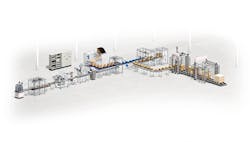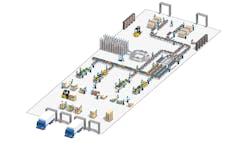Functional-safety requirements dictate conveyor systems
Conveyor systems play an important role in industries like packaging, food and commodity, logistics and semiconductor manufacturing, and they vary depending on the type, weight and dimensions of products being transported and the environment in which they’re installed. One thing that all have in common, however, is a certain set of functional-safety requirements.
A comprehensive approach to keeping your team safe and your machines running will always start with a risk assessment to identify which risks the operators will be exposed to when performing activities like maintenance and troubleshooting.
Also read: Intrinsic safety comes with requirements
Be sure to guard all pinch points
Pinch points are common safety hazards for conveyor systems. As detailed in OSHA 1910.211(d)(44), these are places where part of a person’s body could be caught:
- between the moving parts of a press or auxiliary equipment
- between moving and stationary parts of a press or auxiliary equipment
- between the material and moving part (or parts) of the press or auxiliary equipment.
Nip points are a subcategory of pinch points that involve rotating objects like gears, rollers, belt drives and pulleys. Although the choice of guard will depend on the specific characteristics of the machine, it remains necessary that all pinch points must be guarded to keep operators safe.
When safeguarding pinch points with movable guards, safety interlocks must be used to prevent access to the hazardous area. Some of the common safety interlock models, including noncontact, mechanical interlocks and guard lock interlocks, help to implement the right safety strategy. For example, noncontact door switches coded, either RFID or magnetic, are ideal for applications with fast response times because they do not prevent someone from opening a door. These offer different body shapes and housing materials that make them easy to install yet difficult to bypass.
Another option is guard-locking safety interlocks, which offer different locking configuration options where energy is needed to lock or unlock the safety door switch. The benefit of this type of guard interlock is that it prevents access to the machine while it is operational and offers access to the hazardous area only when power is removed. For a conveyor system where the stopping time of the overall system is higher than the time required to reach a hazardous area, guard-interlocking devices with guard-locking capabilities are required.
Select the appropriate emergency-stop devices
Since conveyors come in different lengths and layouts, it will not always make sense to use a typical pushbutton emergency stop with a mushroom-head shape. This is because workers might not always be close enough to reach the button and stop the system when an emergency occurs.
A cost-effective approach would be to use a rope switch, which offers a range of spans. Rope-switch installation is simple and can be done all along the conveyor’s perimeter. This means that a person working at any point of the conveyor will have easy access to the safety device and will be able pull the cord to stop the system if necessary.
For large sections of conveyors or machinery, instead of using multiple mushroom heads, a safety rope switch offers the easiest way to implement an emergency-stop function for long conveyors thanks to the different rope spans offered with only one switch. It can initiate the emergency-stop function from any point along the installed rope. For correct installation, always refer to the manufacturer’s instructions. A key consideration for most manufacturers will be to ensure that the switch will be activated whenever an operator creates tension in the rope by pulling on it.
Design a working safety circuit
All safety input devices, including e-stop pushbuttons and rope switches, must be connected to safety-rated logic devices, either safety monitoring relays or a safety controller. Non-safety-rated devices are insufficient for this purpose and should not be used. Built-in self-monitoring capabilities and redundant circuits are important for ensuring that the safety function prevails in the case of a component failure like a short circuit. The system should also automatically test the correct opening and closing of the safety devices in each on-off cycle.
For conveyors safety solutions that require more capabilities, manufacturers can implement safety controllers in combination with integrated automation software to help design centralized or modular systems, depending on the level of flexibility required (Figure 1).
Figure 2: You will need to train workers on the important conveyor rules, including general operation and maintenance.
For large systems, where a conveyor has several access points, then the need for safety networks like CIP Safety over Ethernet/IP or Functional Safety over EtherCAT (FSoE) should also be considered. By using safety networks, it is possible to reduce wiring for commissioning and maintenance and prepare companies for their future Industrial Internet of Things (IIoT) strategies that go beyond remote safety system monitoring.
Make sure your operators are well-trained on safety
Once you have implemented a safety solution, and it has been validated and verified, the next step is training. You will need to train workers on the important conveyor rules, including general operation and maintenance (Figure 2). You should also consider training on functional safety to make sure that everyone understands how safety devices work and how they should be maintained.
Since many conveyor-related injuries occur when workers are performing maintenance activities, putting clear lockout/tagout policies in place and training workers on the use of lockout devices to isolate energy sources for machinery to prevent accidental activation is key.
A multifaceted approach is ideal
The best way to ensure safety around conveyor systems is to combine the four strategies discussed in this article. No amount of safeguarding will be sufficient, for instance, if your employees are not well trained. Conversely, no amount of training can justify leaving pinch points unguarded or choosing an unsuitable type of emergency-stop device. Given the complex safety concerns around conveyors, a comprehensive approach is necessary.
Pam Horbacovsky Klancewicz is traceability and vision manager at Omron Automation Americas. Contact her at [email protected].



